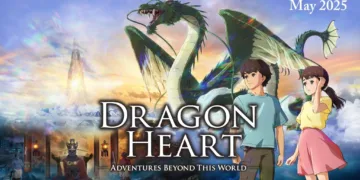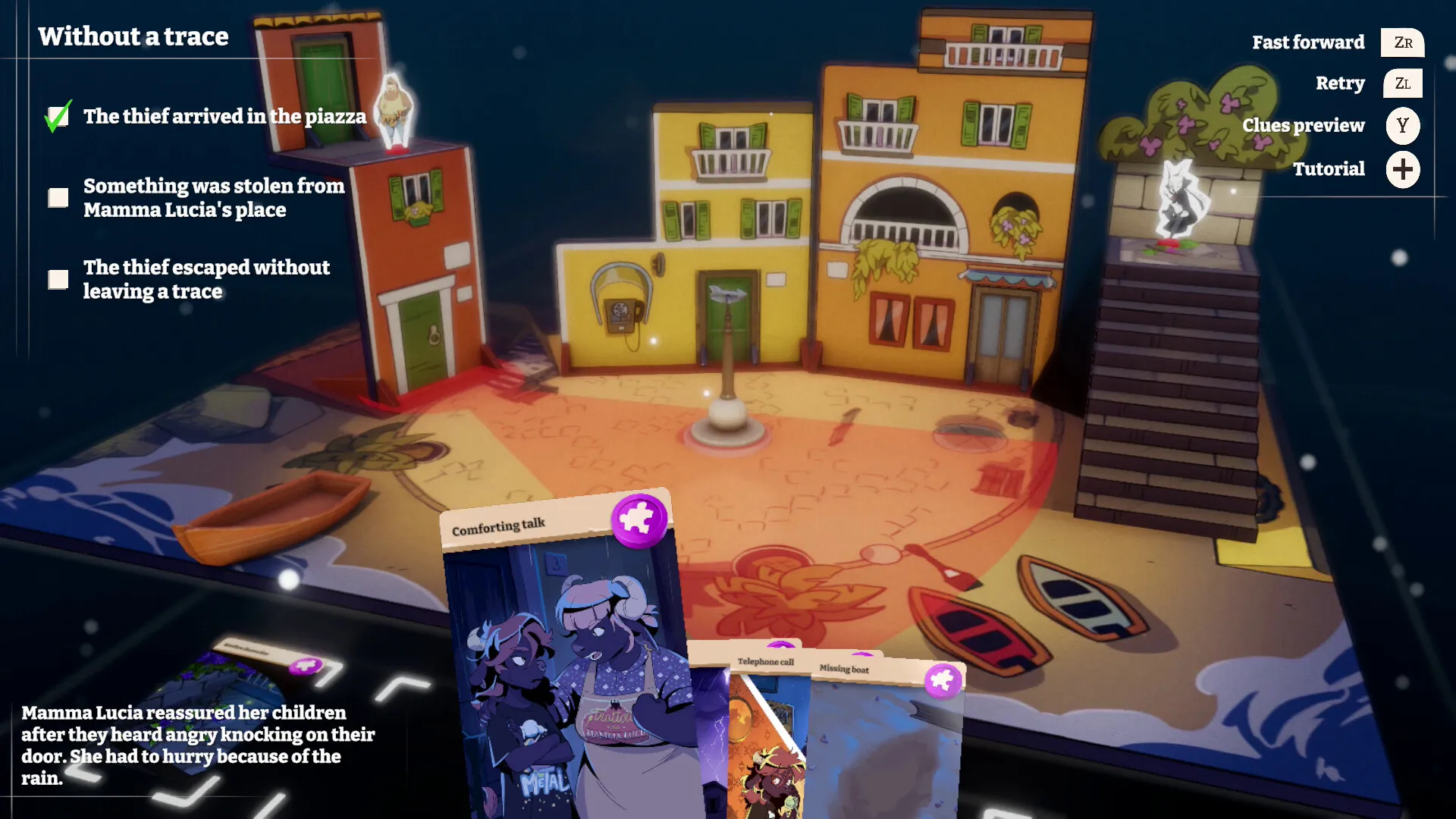In On Your Tail, players take on the role of Diana, a hopeful writer looking for ideas after losing a contest. This event leads her to the charming seaside town of Borgo Marina, where her journey of self-discovery begins. The connection between Diana’s hopes and the bustling town life creates an intimate narrative experience.
Borgo Marina is a beautifully designed place that captures the charm of the Ligurian coast. Its winding streets and bright facades add to the story and make players want to know the community better. Making interactions feel important, each villager provides Diana with knowledge that improves her journey.
The game presents the ideas of friendship and finding out more about yourself, and the choices you make affect Diana’s relationships and personal growth. Focusing on the importance of each connection in a small community, this stress on exploration and community interaction raises the emotional stakes reminiscent of Life is Strange. Here, mechanics and narrative converge, creating an immersive, rich experience.
Weaving Life and Mystery: The Gameplay Mechanics of On Your Tail
On Your Tail is a great game that mixes life simulation and mystery-solving elements, letting players enter the sunny world of Borgo Marina. Through various activities, from fishing to serving gelato, the game focuses on the richness of everyday life.
These mini-games aren’t just for fun; they help players become more involved in the community. Each job feels rewarding, instilling a sense of accomplishment while bringing out the town’s charm. Players can complete these activities at their own pace, allowing for a more relaxed gaming experience, similar to games like Stardew Valley, where the pleasure of doing simple things makes the whole experience more fun.
The relationship-building mechanics further enhance the gameplay by pushing players to establish connections with the people who live in the Town. Every villager has their personality, and talking to them reveals more narrative lines. This part of the choice feels important; Diana’s friendships affect her journey and give her clues that help solve the main mystery. The game combines social relationships with gameplay, making players feel like their decisions are important and have weight.
On the other hand, the mystery-solving features add a new level of interest. To piece together the narrative puzzle, Diana’s Chronicles is a central tool for gathering hints, allowing players to see into the past. This mechanic makes players think more deeply because they must find changes in the environment that reveal secrets. However, the deduction method, which works like a board game, can feel separate from the life sim parts. The card-based gameplay is interesting but can turn into trial-and-error, which might annoy players who want a smoother experience.
Fans of simpler mystery games like Phoenix Wright, where evidence gathering feels more cohesive, might not find the deduction techniques to their liking. The change from life simulation to mystery solving in On Your Tail can disrupt the flow and occasionally pull players out of the immersive experience. However, the balance of everyday activities and engaging mysteries keeps the player interested in both the characters and the narrative.
In the end, On Your Tail has a complex yet approachable blend of gameplay systems that encourage players to discover, connect, and unravel Borgo Marina’s mysterious charm. Adding life simulation and narrative-driven choices increases the game’s emotional effect and enriches the whole experience, making each player’s journey unique.
The Tapestry of Relationships in On Your Tail
Character growth is a big part of the gameplay in On Your Tail, which adds to the narrative and makes the player feel more immersed. The supporting cast is lively and varied, with people living in Borgo Marina having special qualities and stories that add to the town’s charm.
From the mysterious mechanic Chea to the kind gelato maker, these characters are more than just non-playable (NPCs). They represent the community and give Diana’s journey more depth and realism. Making interactions feel meaningful rather than transactional, their personal stories frequently mirror larger themes of hope and fortitude.
As players interact with these characters, Diana’s relationships change naturally. How bonds are formed depends on the choices players make during talks and activities, creating a sense of agency. On Your Tail emphasizes the importance of spending time with characters, unlike many RPGs, where relationships can feel formulaic. This leads to real relationships that make sense on an emotional level. The game pushes players to invest in these friendships, which shows how Diana’s personal growth is linked to the relationships she creates.
In addition, these exchanges greatly affect both the gameplay and the story. The more connections players make, the more dialogue choices and story arcs they can use to learn more about the town and its mysteries. This mechanic enriches the narrative while promoting exploration, making the world feel alive and responsive. In this way, On Your Tail shows how character development can elevate a game from a simple narrative to a highly engaging experience, reminding players that every connection is a part of life’s bigger tapestry.
Aesthetic Harmony in On Your Tail: Visuals and Sound
On Your Tail captivates players with its stunning visual aesthetics, capturing the charm of a Ligurian seaside town through bright colors and careful attention to detail. Each aspect of Borgo Marina is designed to evoke a sense of warmth and nostalgia, and the art style is a delightful mix of reality and whimsy.
With its cobblestone streets and intricately designed storefronts, the environment begs to be explored, making each walk feel like a new adventure. As the beauty of the surroundings mirrors Diana’s journey of self-discovery, this attention to detail increases immersion and supports the narrative.
The lush visuals are paired with a carefully crafted soundtrack that sets the right mood for gameplay. The music runs naturally between upbeat melodies during lighthearted activities and more somber tones during mystery-solving sections, perfectly reflecting the emotional range of the game. This dynamic score improves the player’s experience, allowing for a stronger connection to the environment and the story as it develops.
The sound design elevates the mood by adding background noises like the soft crashing of waves or the chatter of people far away. The charming dialogue makes each character feel real and engaging, even though there isn’t much voice acting. On Your Tail’s audio and visuals create a seamless experience that enriches the narrative and entices players to get lost in the magical world as they unravel its mysteries.
The Rhythm of Discovery in On Your Tail: Pacing and Structure
On Your Tail presents a unique challenge in combining life simulation and mystery elements by creating an engaging and occasionally disjointed rhythm. While also moving forward with the main mystery, the game’s pacing encourages players to get lost in everyday activities like fishing or serving gelato. This dual focus questions the overall narrative flow, which allows players to invest in the charming world of Borgo Marina.
One big problem is how the game is structured, especially how it tends backward. Players frequently find themselves going back over their steps to finish jobs or find clues, which can disrupt the narrative. For example, Diana may find it boring to repeatedly go back to the same places to talk to NPCs or get things.
This choice in design can detract from the immersive experience, making exploration feel more like work than an adventure at times. Games like Firewatch, on the other hand, keep the narrative moving forward by focusing on exploration, allowing players to feel constantly involved without having to do too much backtracking.
The player’s choices influence Your Tail’s pacing and pleasure. The gameplay is improved by optional activities, which also help Diana grow as a character. However, the allure of these side quests can occasionally overshadow the main narrative, causing players to put more emphasis on life simulation features than mystery development. This balance creates a tense but pleasant tension. The freedom to explore gives the player more control, but it can also take away from the main plot, making some mysteries feel less important than the lovely routine of village life.
Ultimately, how the life sim and mystery features work together in On Your Tail shows how complicated storylines can be in games. Players must find their routes while keeping an eye on the main narrative because the balance is delicate. The richness of the world and the emotional depth of its characters provide a rewarding journey that encourages discovery and connection, even though some may find the pacing inconsistent at times.
Navigating the Technical Waters of On Your Tail
On Your Tail has some technical problems, even though it provides a charming and engaging experience. Some players have said the game has bugs, like character animations, stuttering, or goal markers not updating.
These problems may pull players out of the exquisitely made world, which can disrupt immersion. Loading times can also feel longer than expected, especially when moving from one area to another, which can be annoying for people eager to get back into the narrative.
The game works pretty well on both PC and Switch in terms of general optimization, but there are some big differences. Players get better images and faster PC load times, improving the experience. On the other hand, the Switch version may experience frame rate drops during more difficult scenes, which can detract from gameplay fluidity, though it is still fun.
The difference in performance between platforms highlights the importance of technical polish, as players on different devices might not have the same smooth experience. The base is strong, but these technical issues could elevate On Your Tail from a fun journey to a seamless adventure.
The Review
On Your Tail
In On Your Tail, life simulation and mystery elements are expertly woven together, creating an engaging life experience with many character exchanges and a lively world. The emotional depth and player agency make the journey worthwhile, even though some pacing and technical problems detract from immersion. Although the balance between side quests and the main narrative sometimes feels off, the game's charming aesthetics and thoughtful design encourage exploration. It's a heartfelt adventure that works for both new and experienced players.
PROS
- Engaging character development and relationships.
- Beautifully crafted visuals and immersive environment.
- Strong player agency with meaningful choices.
- Relaxed pacing that invites exploration.
- Dynamic soundtrack that enhances gameplay atmosphere.
CONS
- Occasional technical issues and bugs.
- Backtracking can disrupt narrative flow.
- Some players may find side quests overshadow the main story.




















































